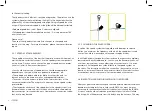
13
4.4 FLYING WITHOUT BRAKE LINES
If, for any reason at all, the IKUMA 2’s brake lines become disabled in
flight, it will become necessary to pilot the wing with the C-risers and
weight shifting until landing. These risers steer easily because are not
under significant tension. You will have to be careful and not handle them
too heavily in case this causes a stall or negative spin. The wing must
be flown at full speed (not accelerated) during the landing approach, and
the C-risers will have to be pulled symmetrically all the way down shortly
before contact with the ground. This braking method is not as effective
as using the brake lines, and hence the wing will land with a higher
ground speed.
4.5 LINE KNOT(S) IN FLIG
The best way to avoid knots and tangles is to thoroughly inspect the lines as
part of a systematic pre-flight check. If a knot is spotted during the take off
phase, immediately abort the launch sequence and stop.
If inadvertently taking off with a knotted line, the glider drift will need to be
compensated by weight-shifting to the opposite side and applying a slight
brake pull to that side. Gently pull the brake line to see if the knot can be
undone or try to locate the problem line. Try pulling it to see if the knot can
be undone. Beware of trying to clear a knotted line or untangle a line in flight
when close to the terrain. If the knot is too tight and cannot be undone,
carefully and safely fly to the nearest landing zone. Be careful: do not pull too
hard on the brake handles because there will be an increased risk of stalling
the wing or entering a negative spin. Before attempting to clear a knot, make
sure there are no other pilots flying in the vicinity.
5. LOSING ALTITUDE
Knowledge of different descent techniques could become vital in
certain situations. The most suitable descent method will depend on the
particular situation.
To become familiar with the manoeuvres described below, we
recommend practising within the environment of a licensed training outfit.
5.1 BIG EARS
The “Big ears” is a moderate descent technique, able to increase the sink
rate to –3 or –4 m/s and reduces the ground speed by 3 to 5 km/h. The
angle of attack and effective wing-loading will also increase due to the
smaller surface area of the wing.
Standard technique
To perform the ‘Big ears’ manoeuvre, take the outermost line on
each 3A3-riser and simultaneously, smoothly pull them outward and
downward. The wingtips will fold in.
To re-establish forward speed and the correct angle of attack, accelerate
once the ears are pulled.
Keep the ears pulled in until you have lost the desired altitude.
Let go of the lines to re-inflate the tips automatically. If they do not, try
progressively pulling one brake then the other. We recommend inflating
the wing tips asymmetrically, without major change to the angle of
attack, especially when flying near the ground or flying in turbulence.
Beware of the risk of stalling!
The action of reaching for the outermost 3A3-lines to make ears, can
inadvertently mean pulling the brakes. The same can happen when we
are holding the tips down with the outermost 3A3-lines, it is possible to
accidentally affect the brakes. This can obviously lead to a significant
Summary of Contents for IKUMA 2
Page 1: ...IKUMA 2 User s manual...
Page 19: ...19...
Page 22: ...10 3 RISERS PLAN 22...
Page 23: ...10 4 SUSPENSION PLAN 23...
Page 29: ...niviuk com...














































